Doctor Who: a salute to Steven Moffat’s legacy
Now that Steven Moffat's tenure as Doctor Who showrunner has come to an end, we salute all the Moffat era gave to the show...
Steven Moffat has written more of Doctor Who for television than any other writer in history. He’s also won more awards for writing Doctor Who than any other writer, which should tell you something about his hit rate.
Like anyone doing a job in this show for an extended period of time, he has his fans and his detractors, but there’s no way of overstating his contribution to the show in the last 12 years, and going back before the revival was even on the cards, or forward into the future, with his Target-style novelisation of The Day Of The Doctor coming this April. In fact, we’d argue that his decision to move on after writing for the series at least once a year every year since it came back in 2005 is rather a bigger deal than we have fully been able to parse just yet.
Robert Holmes has him beat for overall episodes, back in the shorter, serialised era, but minute for minute, Moffat is more prolific than any other writer. He’s also written for the First, Fifth, Eighth, Ninth, Tenth, Eleventh and Twelfth Doctors, and created two new incarnations in the shape of John Hurt and Tom Baker (again).
Having worked on the show for so long, in one way or another, there are those who claim he ran out of ideas after a certain point, but there’s an important distinction to be made between regurgitating the same plots and coming back to certain themes that interest him about Doctor Who. These themes are consistent throughout his work, even going back to the very first pieces of Doctor Who he ever wrote.
“I bribed the architect first…”
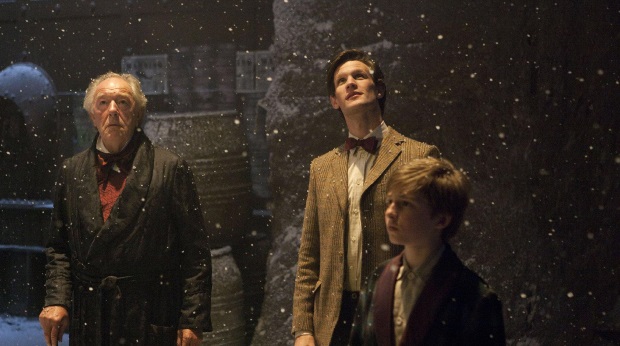
Moffat’s short story Continuity Errors appeared in the 1996 Virgin Books anthology Decalog 3: Consequences. In this story, the Seventh Doctor contends with a grumpy librarian who refuses to lend him a book on a war in the distant past, which he’s planning to use to save thousands of lives.
Travelling back through her timeline, he attempts to change her perception of him through acts of kindness, with the side effect that her life in the present stops making sense to her. Moffat reused this idea in his re-telling of A Christmas Carol in Matt Smith’s first Christmas special, with the Eleventh Doctor acting as the ghost of Christmas past to Michael Gambon’s Scrooge-like miser, Kazran Sardick.
In terms of repetition, the planet-sized library (so big, it doesn’t need a name) from Continuity Errors made an appearance in 2008’s Silence In The Library, and an anti-Doctor professor, Arthur Candy, appears in person at the end of Let’s Kill Hitler when River Song applies to university. But it’s the thematic repetition that interests us here, giving us two key principles that recur throughout Moffat’s Who writing:
1) Time can be rewritten2) The Doctor is kind
The first of those principles is foregrounded in his extended Red Nose Day 1999 skit, The Curse Of Fatal Death. This affectionate parody runs 25 minutes long and establishes more of Moffat’s tropes than his actual principles for writing the Doctor.
In the story, Rowan Atkinson’s Ninth Doctor is retiring to marry his companion Emma (Julia Sawalha), and arranges a meeting with the Master (Jonathan Pryce) to tell him the news in a castle on the planet Terserus. A convoluted game of one-upmanship ensues as the two Time Lords take turns bribing the architect of the castle, until the Master spends over 900 years clambering in and out of a labyrinthine sewer system.
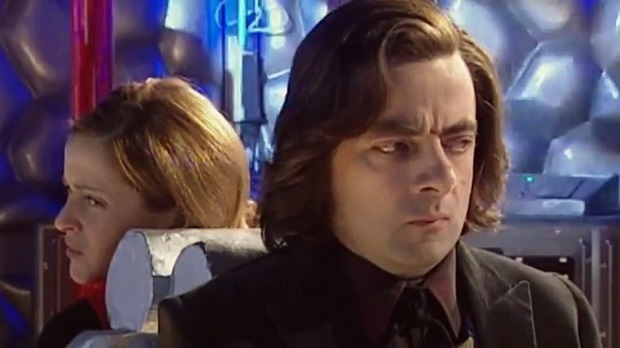
Moffat had his start in television writing sitcoms, from CITV’s Press Gang to the super Moffat-y Friends analogue Coupling, but even in a Comic Relief spoof, there’s as much genuine affection for the show as there is irreverence. For instance, it ends in a regeneration lottery through the Doctor’s remaining lives, but culminates in Emma eulogising him with the “never cruel and never cowardly” line that writer Terrance Dicks coined in 1976’s The Making Of Doctor Who. Like Moffat, we’ll come back to that.
Unlike most skits of this kind, The Curse Of Fatal Death absolutely scans as a Doctor Who story, even if it is an exceptionally silly one. That shows in the way that Moffat has been able to re-tailor certain elements in his later episodes, in which Series 9’s The Magician’s Apprentice and The Witch’s Familiar is almost a more serious remount of the story, with added Davros.
There are Daleks, the Master (now Michelle Gomez’s Missy), some big bloody sewers and even a reprise of that joke about the redundancy of chairs on Skaro. But tell us that cold open with young Davros isn’t one of the greatest openings to a story you’ve ever seen, and then maybe you could call it unoriginal.
But just for those counting the weird coincidences – the Tenth Doctor (Richard E. Grant) foreshadows David Tennant’s oral fixation when he calls himself “lick the mirror handsome”; the Eleventh Doctor (Jim Broadbent) sheds all of his immediate predecessor’s flirty confidence and is generally more physically awkward; the Twelfth Doctor (Hugh Grant) is convinced that he’s not going to regenerate, right up until he turns into a woman (Joanna Lumley). Weird…
“Wibbly wobbly, timey wimey”

In the show proper, some of the irreverence rubs certain fans the wrong way, but Moffat’s experience in sitcoms is as vital to his style of writing Doctor Who as Russell T. Davies’ experience on soaps and children’s TV drama. Good sitcoms are as underrated as good soaps in the world of TV criticism, but it’s the structural discipline of the former that distinguishes Moffat’s episodes of Who.
More than characters who can just run and run in a new situation every week, sitcoms are based around setups and payoffs and Moffat writes those to a tee. Sometimes the punchline is the reveal that a ship full of confused androids is actually named the SS Madame du Pompadour, sometimes it’s the reveal that River Song dies the first time the Doctor meets her, or that she’s Amy and Rory’s daughter, or that she’s notorious for murdering the Doctor, or any one of a number of pay-offs involving that character.
In character terms, the sitcom approach is most successful in Moffat’s first two full series, with the family unit of the Ponds and their best mate turned son-in-law, and his last series, which gives Peter Capaldi’s Twelfth Doctor a perfect foil in brilliant, bubbly and inquisitive Bill Potts, and even his own, updated K9 in the form of Nardole.
Moffat’s first and last full series are the most consistently liked periods of his tenure as executive producer, because whenever it’s just the Doctor and Clara in between, their dynamic proved more eclectic from series to series. Under Moffat, the show has proven stronger with a Team TARDIS that can move from one adventure to the next with less fuss.
While issues of Jenna Coleman’s changing availability were a factor, perhaps the reason why Clara comes in for some flak from fans is that she doesn’t essentially ‘reset’ for the next situation at the end of each episode, firstly as a result of the ‘impossible girl’ arc and thereafter as a result of her domestic grounding. It’s only less consistent, not less watchable, and coupled with a sense of humour, the experimental edge of Moffat’s series is a big part of what made them so watchable.
“Don’t blink”
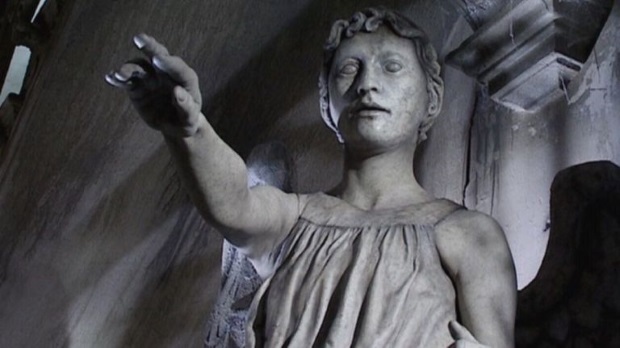
For one thing, while he has embellished the scarier edges of some of Doctor Who‘s top tier of antagonists, Moffat doesn’t do monsters that much. He creates characters like Rusty the Dalek, Handles the Cyber-head, Strax the Sontaran, Madame Vastra the Silurian – his monsters aren’t monsters, but characters.
So the really scary stuff comes from elsewhere. When asked about his horror ideas, Moffat has described himself as a scaredy cat, and we get a good idea of what scares him from his Doctor Who stories. This proliferates across the episodes from his time as showrunner too, but in the episodes he wrote himself, it often comes down to either sight, memory or time. The Silence must really frighten him, because you forget about them when you see them, and they’ve been around forever.
But taken and analysed separately, there’s the obvious importance of sight when combatting the Weeping Angels. Even if the episodes subsequent to Blink had a tendency to complicate the terrifyingly simple creation, as horror movie sequels do, it’s ultimately based around a terror of something you can’t see, which proved to be a pain for the Twelfth Doctor in the mid-section of Series 10 as well. We see that turned to other uses in Richard Curtis’ Vincent And The Doctor too, where a depressed Van Gogh literally contends with invisible monsters.
Also in that episode, Amy doesn’t know she’s grieving over the loss of Rory, who is erased from time one episode prior. In addition to the aforementioned Silence, Moffat mines a lot of horror out of people forgetting someone or something they have just seen throughout his first series, including the cracks in time, and the electoral satire of The Beast Below, in which an entire population votes to forget everything they know about their government and its abuses of power, every five years.
Finally, time is a biggy. It’s a laugh to watch Jonathan Pryce get older and stinkier on his voyages through the sewers, but the waiting periods that come with time travel have often been a source of horror in Moffat’s Who. Like Reinette in The Girl In The Fireplace, Amy waits years for the Doctor to come back for her. Rory waits centuries for Amy in The Big Bang. Bill waits a decade for the Doctor to pull his socks up and come downstairs in World Enough & Time.
“We get that word from you, you know.”
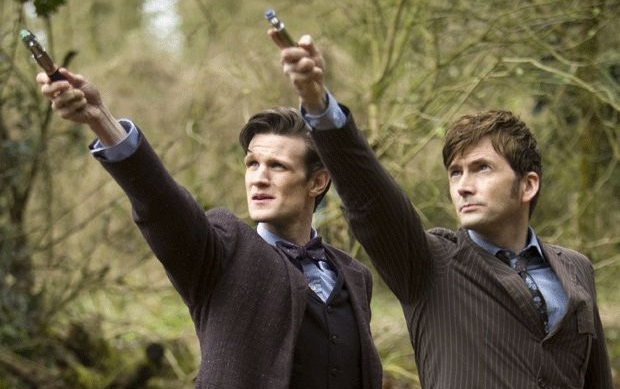
That’s not even mentioning the Doctor. He’s 907 in The End Of Time, Davies’ last episode, but Moffat has him wait for so long in episodes like The Time Of The Doctor and Heaven Sent that he’s 2,000 years old in story time by the end of Twice Upon A Time, with a billion years’ worth of bad memories under his belt. As the showrunner who cast the youngest actor ever to play the Doctor, followed by the eldest, the age of the lead character has been another recurring theme of Moffat’s.
Moffat’s Doctor is the being who has been around so long, we learn in A Good Man Goes To War, inspired the word he chose as his own name, canonising a fan theory that the writer posted on a fan forum some years ago. By the time the Twelfth Doctor is refusing to regenerate in his last two episodes, you can appreciate why he’s ready for a bit of a rest.
But here, the Doctor holds Moffat’s own principles. ‘Time can be rewritten’ and ‘The Doctor is kind’, with the latter gradually expanding into ‘never cruel, never cowardly’, another quote he canonised. The apotheosis of this character and those principles comes in Moffat’s best episode, The Day Of The Doctor, a confluence of all of his tropes that gloriously retcons the biggest question mark over the new series, by revealing, finally, that the Doctor didn’t kill his own people.
“People think of that story – quite rightly – as Doctor Who at its most summer blockbuster simple,” Moffat told TV Choice recently. “In fact, it is by far and away – by far and away – the most complicated, timey-wimey story, ever done in Doctor Who.”
It’s the most Moffat-y of Moffat’s stories and it’s the Rosetta stone of his period as the Doctor Who fan who got to run Doctor Who because it treats the Doctor with the importance he deserves, within the world of the show itself. That doesn’t always pay off in other episodes, but here it’s an evolution from the strings-free continuation of RTD’s era, making a 50th anniversary special that feels worthy of the label ’50th anniversary special’.
That canonised status and love for the Doctor affects the representation of companions too. If Clara and Bill are co-leads, they’ll live up to the Doctor, right up to when they leave. Script editor Andrew Ellard (whose Tweetnotes series makes him well worth a follow on Twitter) put it wonderfully when he pointed out that as of The Doctor Falls, both of Twelve’s companions are “elevated to pro Doctors, while the Doctor himself remains a keen amateur”.
This level of fan service hasn’t necessarily kept it at the peak of popularity that it was back in Davies’ era, but with the TARDIS getting a fresh lick of paint under Chris Chibnall, the fans who enjoy this sort of thing can be grateful that Moffat managed to integrate it while still maintaining its reputation as lively, intelligent television.
“Look after the universe for me. I’ve put a lot of work into it.”
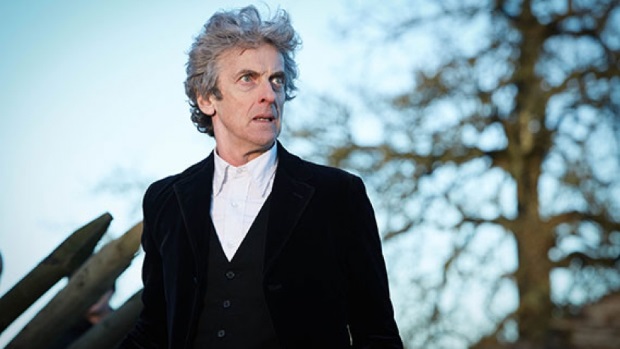
Perhaps you don’t agree with my assertion that The Day Of The Doctor is Steven Moffat’s best Doctor Who story. Maybe you prefer The Empty Child, or The Girl In The Fireplace, or Blink, or The Eleventh Hour, or The Pandorica Opens, or Listen, or Heaven Sent, or World Enough & Time and The Doctor Falls, but even if you disagree on the ranking, that’s a hell of a lot of all-time great Doctor Whos from one writer.
We all have our criticisms of him, but some of the most loudly repeated ones fall apart fairly easily under consideration, and chief among those is that the show suffered because he was working on Sherlock. Moffat has turned out six series since taking over, having originally only intended to do three, and timing-wise, this has been in keeping with RTD’s prediction that the series would have to take gap years every once in a while. His predecessor often spoken of how the job left him feeling burnt out and he did four series and some specials.
The budget won’t have been getting larger as the BBC has been forced to cut costs in recent years, it’s impressive that the show looks better than it ever has done, thanks to some creative directors and line management, with only one less episode a year. This year’s 10 episode run is probably the next sensible adjustment for inflation.
Finally, the most recent ‘gap year’ in 2016 meant a long wait between the Christmas specials The Husbands Of River Song and The Return Of Doctor Mysterio, but the former of those was originally supposed to be Moffat’s final episode. But with the BBC prepared to wait until this year for Chris Chibnall to take over, there may not have been anything since 2015 if not for Moffat doing another series.
And what a series it was, giving us that gorgeous team of Capaldi, Pearl Mackie and Matt Lucas, on the way to that devastating finale. Like The Time Of The Doctor, The Doctor Falls is another climactic episode that sees the Doctor die during a vast battle, but they couldn’t feel more different. In the former, time can be rewritten. In the latter, the Doctor is kind. These are thematic staples of Moffat’s run and the best answer to his critics who say that he repeated himself is that it never felt the same when he did.
His experiments with format also contributed to some fan umbrage, with each series he ran taking a different format. During Smith’s run, Series 5 is the tried-and-tested 13 episodes of the RTD era; Series 6 was split around a US style mid-season finale; Series 7 was the ‘slutty movie poster titles’ year of one parters (again split, around a casting change this time).
Then for Capaldi, series 8 had more of an arc, with an existential bent to suit a more thoughtful new Doctor, Series 9 was more involved and almost completely made up of multi-part stories, and Series 10 went back to standalones with a loosely connected mid-series arc and a two-part series finale. And then, just to top it off, he ended on Twice Upon A Time, a unique regeneration episode that feels like a hard-earned lap of honour.
We’ve come to praise Steven Moffat, not to bury him, because his contribution to Doctor Who is more than deserving. He’s said that he won’t write any more for the time being, and love him or hate him, you can’t begrudge him a rest. This year will be only the second since 2005 without an episode written by him. If that’s not the end of an era, we don’t know what is.
